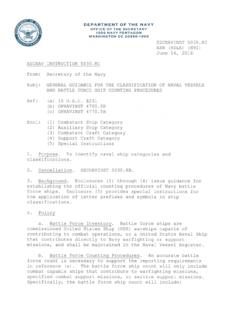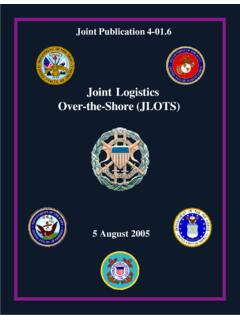Transcription of u . s . c
1 D EPARTMENT OF THE NAVY OFFICE OF THE SECRETARY 1000 N A V Y PENTAGON WASHINGTON OC 20350-1000 SECNAV INSTRUCTION From: Secretary of the Navy SECNAVINST N9I 7 MAR 14 Subj: GENERAL GUIDANCE FOR THE CLASSIFICATION OF NAVAL VESSELS AND BATTLE FORCE SHIP COUNTING PROCEDURES Ref : (a) 1 0 u . s . c . 2 31 (b) OPNAVINST (c) OPNAVINST Encl: (1) Combatant Ship Category (2) Auxiliary Ship Category (3) Combatant Craft Category (4) Support Craft Category {5) Special Instructions 1. Purpose. To identify naval ship categories and classifications. 2 . Cancellation. SECNAVINST 3.}
2 Background. Enclosures (1) through (4) issue guidance for establishing the official counting procedures of Navy battle force ships. Enclosure (5) provides special instructions for the application of letter prefixes and symbols in ship classifications. 4. Policy a . Battle Force Inventory. Battle force ships are commissioned United States Ship (USS) warships capable of contributing to combat operations, or a United States Naval Ship that contributes directly to Navy warfighting or support missions and shall be maintained in the Naval Vessel Register. b. Battle Force Counting Procedures.
3 An accurate battle force count is necessary to support the reporting requirements in reference (a). The battle force ship count will only include combat capable ships that contribute to warfighting missions, specified combat support missions, or service support missions. Specifically, the battle force ship count will include: SECNAVINST 5030. 88 7 MAR 14 (1) Ship types listed in enclosure (1) that are classified as Active, Military Sealift Command (MSC), Naval Fleet Auxiliary Force, Navy Reserve Force (NAVRESFOR), or MSC Special Mission, with the following exceptions: (a) MSC ships assigned a reduced operating status of 45 days or less may be counted on a case-by-case basis as recommended by the Chief of Naval Operations (CNO) with Secretary of the Navy (SECNAV) approval.
4 (b) NAVRESFOR active ships are mobilization forces, category "A" assets, and ships that are a part of the battle force. NAVRESFOR active ships have a reduced or skeleton crew of active duty personnel assigned to provide training of assigned reservists for limited operations and maintenance. (c) Ship types which have been routinely requested by a Combatant Commander and are allocated via the Global Force Management Allocation Plan (GFMAP) may be counted on a case-by-case basis as recommended by the CNO with SECNAV approval. This will be a temporary authorization to include these ships in the ship count and will remain in effect until the ships are no longer requested in the GFMAP or are retired (whichever occurs first).
5 Recommendations for action under this rule will be prepared by the Office of the Chief of Naval Operations (OPNAV) Shipbuilding and Conversion, Navy (SCN) Manager in coordination with OPNAV N31. (2) All other craft and auxiliaries listed in enclosures (2) through (4) are not included in the battle force ship count. (3) Ships entering and leaving the battle force inventory. (a) Battle force ships are counted as part of the Navy's active inventory effective upon acceptance by the Navy's accepting authority, Commander, Naval Sea Systems Command (COMNAVSEASYSCOM). Upon acceptance, the CNO will be notified immediately via naval message per reference (b).
6 (b) Ships will no longer be counted as part of the battle force inventory effective upon a ship's official date of decommissioning, being placed "out-of-service," or in the case of nuclear vessels, upon commencement of the ship's inactivation availability. The CNO will be notified of a ship's retirement via naval message per reference (c). 2 SECNAVINST 7 MAR 14 (c) For the purpose of the battle force count in the Annual Long-Range Plan for Construction of Naval Vessels, ships will be counted for the fiscal year t hey are accepted by the Navy and not counted the fiscal year they are removed from service.
7 5. Responsibilities a . CNO (1) Maintain the battle force ship inventory. (2) Enter vessels into the battle force ship i nventory and the Naval Vessel Register upon delivery to a COMNAVSEASYSCOM representative. (3) Delete vessels from the battle force ship inventory upon the ship's official date of retirement as described in paragraph 4b(3) (b). b. COMNAVSEASYSCOM. Support the CNO's daily ship count and notify CNO, via naval message, within 24 hours of a ship's delivery announcing acceptance by the Navy. Distribution should include Standard Naval Distribution List (SNDL) address "CNO WASHINGTON DC//N00/N09/DNS/Nl/N2/N6/N3/N5/N4/N43/N8 /N80/ N9/N9I/NXX//," copy "COMUSFLTFORCOM NORFOLK VA//N01F/N3/N4/N8//" and "COMPACFLT PEARL HARBOR HI//NOOF/N3/N4/N8//.
8 " "NXX" represents the respective OPNAV ship resource and platform sponsor. c . Commander, U. S . Fleet Forces Command and Commander, Pacific Fleet. Per reference (c), notify CNO via naval message when a non-nuclear battle force ship has officially retired and upon the start of a nuclear ship's inactivation availability in support of subsequent decommissioning. 6 . Records Management. Records created as a result of this instruction, regardless of media and format, shall be managed per SECNAV Manual 5210. 1 of January 2012. 3 Distribution: SECNAVINST 7 MAR 14 Electronic only, via Department of the Navy Issuances Web site: 4 SECNAVINST 7 MAR 14 COMBATANT SHIP CATEGORY 1.
9 Warship Classification. Any commissioned ship built or armed for naval combat. a . Aircraft Carrier. All ships designed primarily for the purpose of conducting combat operations by aircraft which engage in attacks against airborne, surface, sub-surface, and shore targets. Conventional Take Off and Landing Aircraft Carriers. Multi-purpose aircraft carrier (nuclear-powered) (CVN) . b . Surface Combatant. Surface ships that are designed primarily to engage in attacks against airborne, surface, subsurface, and shore targets. (1) Cruisers. Guided missile cruiser (CG).
10 (2) Destroyers. Guided missile destroyer (DDG). (3) Frigates. Guided missile frigate (FFG). (4) Littoral Combat Ships. Littoral combat ship (LCS). c. Submarine. All self-propelled submersible types regardless of whether employed as combatant, auxiliary, or research and development vehicle, which have at least a residual combat capability. (1) Attack Submarines. Submarine (nuclear-powered) (SSN). (2) Ballistic Missile Submarines. Ballistic missile submarine (nuclear-powered) (SSBN) . (3) Guided Missile Submarines. Guided missile submarine (nuclear-powered) (SSGN).




